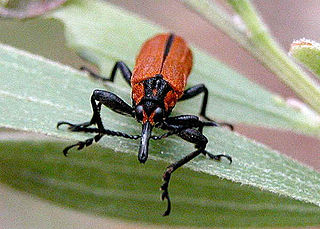
Heterorhabditis is a genus of nematodes belonging to the order Rhabditida. All species of this genus are obligate parasites of insects, and some are used as biological control agents for the control of pest insects.

Black vine weevil is an insect native to Europe but common in North America as well. It is a pest of many garden plants.

Stilbenoids are hydroxylated derivatives of stilbene. They have a C6–C2–C6 structure. In biochemical terms, they belong to the family of phenylpropanoids and share most of their biosynthesis pathway with chalcones. Most stilbenoids are produced by plants, and the only known exception is the antihelminthic and antimicrobial stilbenoid, 2-isoprpyl-5-[(E)-2-phenylvinyl]benzene-1,3-diol, biosynthesized by the Gram-negative bacterium Photorhabdus luminescens.

Photorhabdus luminescens is a Gammaproteobacterium of the family Morganellaceae, and is a lethal pathogen of insects.

The nematodes or roundworms constitute the phylum Nematoda, with plant-parasitic nematodes being known as eelworms. They are a diverse animal phylum inhabiting a broad range of environments. Taxonomically, they are classified along with insects and other moulting animals in the clade Ecdysozoa, and unlike flatworms, have tubular digestive systems with openings at both ends. Like tardigrades they have a reduced number of Hox genes, but as their sister phylum Nematomorpha has kept the ancestral protostome Hox genotype, it shows that the reduction has occurred within the nematode phylum.

Heterorhabditis bacteriophora is a species of entomopathogenic nematode known commonly as beneficial nematodes. They are microscopic and are used in gardening as a form of biological pest control. They are used to control ants, fleas, moths, beetles, flies, weevils, and other pests. They are also amenable to in vitro culture, making them also of interest to evolutionary and molecular biologists who investigate parasitic and symbiotic systems. Heterorhabditis bacteriophora was selected by the National Human Genome Research Institute as a sequencing target, the inbred strain H. bacteriophora TTO1 was sequenced using Roche 454 technology, and a high-quality 77 Mb draft genome assembly was produced in 2013. To reproduce the nematodes release Photorhabdus bacteria from their digestive tract thus killing these pests, then using the cadaver to grow and reproduce.
The biosynthesis of phenylpropanoids involves a number of enzymes.
Photorhabdus is a genus of bioluminescent, gram-negative bacilli which lives symbiotically within entomopathogenic nematodes, hence the name photo and rhabdus. Photorhabdus is known to be pathogenic to a wide range of insects and has been used as biopesticide in agriculture.

Benvitimod is a bacterial stilbenoid produced in Photorhabdus bacterial symbionts of Heterorhabditis nematodes. It is a product of an alternative ketosynthase-directed stilbenoids biosynthesis pathway. It is derived from the condensation of two β-ketoacyl thioesters. It is produced by the Photorhabdus luminescens bacterial symbiont species of the entomopathogenic nematode, Heterorhabditis megidis. Experiments with infected larvae of Galleria mellonella, the wax moth, support the hypothesis that the compound has antibiotic properties that help minimize competition from other microorganisms and prevents the putrefaction of the nematode-infected insect cadaver.
Providencia rettgeri, is a Gram negative bacterium that is commonly found in both water and land environments. P. rettgeri is in the genus Providencia, along with Providencia stuartii, Providencia alcalifaciens, and Providencia rustigianii. P. rettgeri can be incubated at 37 °C in nutrient agar or nutrient broth. It was first discovered in 1904 after a waterfowl epidemic. Strains of the species have also been isolated from nematodes of the genus Heterorhabditis.

Rhinotia haemoptera, the red weevil, is a beetle species in the genus Rhinotia found in Australia. It resembles a fire-coloured beetle (Pyrochroidae) in colour. This insect pest can destroy groves and plantations of coconut and migrate to date palms and other palms, causing economic damage to farmers and landscapers.
Heterorhabditis indica is a nematode species in the genus Heterorhabditis.
Photorhabdus temperata is a species of bacteria. It has been divided into 6 subspecies. It is pathogenic to certain insects.

Heterorhabditis megidis is a species of nematodes in the genus Heterorhabditis. All species of this genus are obligate parasites of insects, and some are used as biological control agents for the control of pest insects.
Heterorhabditis heliothidis is a nematode species in the genus Heterorhabditis.
Postelectrotermes militaris is a species of drywood termite of the genus Postelectrotermes. It is native to India and Sri Lanka. It is a serious pest of tea.
The Low-country tea termite,, also known as Low country live wood termite, is a species of damp wood termite of the genus Glyptotermes. It is endemic to high elevations Sri Lanka. It is a major pest of tea in low country area of Sri Lanka.
The Steinernematidae are a family of nematodes in the order Rhabditida.






